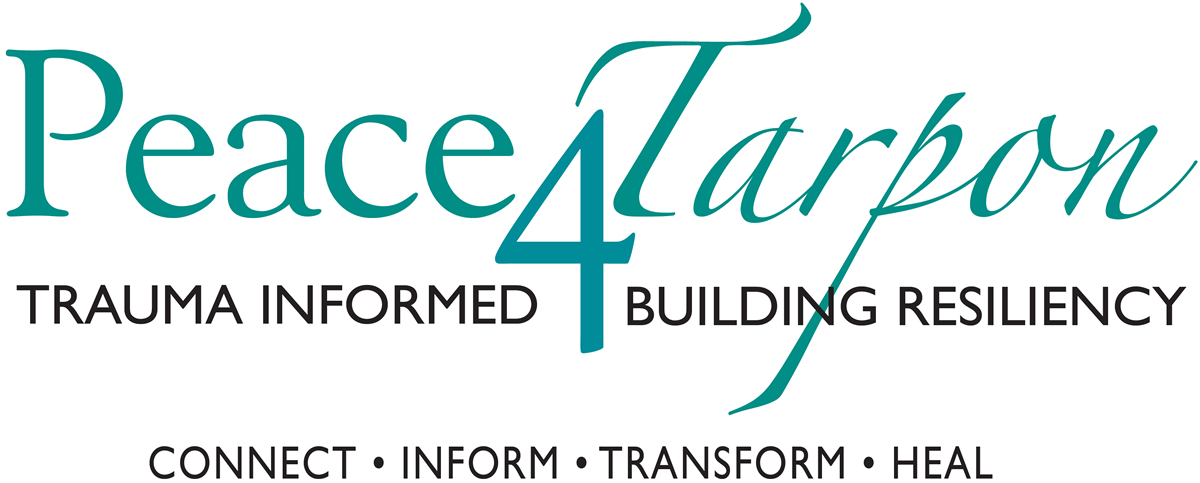A few weeks back, a participant in a conference call about trauma-informed communities asked me an interesting question: “If I were to come to Tarpon Springs, would I notice anything different about it? Would I be able to tell that it’s trauma-informed and that Peace4Tarpon had an impact?”
The question gave me pause. That’s what we hope for, but how would we know?
I’ve been thinking a lot lately about what it means to be a trauma-informed community — not only how we measure up, so to speak, but how and when does culture change and a shift in perspective arrive? How do we know we’re “there” — wherever “there” is?
Bottom line, we are a work-in-progress. Big change and evolution happen at micro-levels. It’s just like aging. We don’t notice the small daily changes in our faces or bodies until we see a photo from a few years ago and have one of those “Oh, wow, I looked so young then!” moments.
I think that’s how it’s working with us.
Our journey together creates more depth in our understanding of trauma, trauma resolution, and resilience — even the ego strength needed to really process stuff. All of it is fascinating and amazing to be part of as both observer and participant and all of it is couched squarely within the principle of voice and choice.
A few months ago, we had an interesting experience at one of our monthly Forums. At the back of the room was a woman I didn’t recognize. That’s not unusual — new folks come to our meetings every month. But when we went around the room to do quick introductions, there came an unexpected moment that was sobering, interesting, and that prompted me to ask myself some hard questions.
“Sarah” introduced herself and said she hoped she was in the right place. She had discovered Peace4Tarpon on the Internet as a “trauma-informed community” and had made the trek from South Florida to attend our forum. Not a big deal – right? People visit us from all over the map.
She went on to say that she had autism-spectrum disorder and that it was really hard for her to speak in front of us and to be in the room. Indeed, she looked very uncomfortable — rocking, wringing her hands, looking down at her lap. And suddenly I realized a couple of things.
First — it was pretty amazing she made it from South Florida to Tarpon Springs on her own as by outside eyes, her mannerisms would be seen as eccentric at the very least. Worst case, she might be labeled “mentally ill” and taken into protective custody.
Second — I also saw Sarah as an amazingly brave person to be in the room and to speak in front of this large group of strangers.
She went on to explain that when she read about Peace4Tarpon and Tarpon Springs on-line, she thought to herself that maybe this was a safe place where she would be accepted and be able to be part of the community.
I was stunned. All of a sudden, there was a huge magnifying glass pointing right at us. How were we measuring up? Would we be able to truly welcome and accept Sarah? Were we a safe place?
At one point Sarah became overwhelmed and one of our partners took her to the employee break-room next door where she could regroup. There is a “rest of the story” and it’s also pretty amazing, but the question that remains and still looms large — How did we measure up? What about the next time?
As communities work toward becoming trauma-informed, experiences like this are likely to continue. It’s one thing to be something on paper or in a meeting, or working on programs or projects, but a trauma-informed community is more than any of that. It’s about community. It’s about creating safety, choice, voice, trust, empowerment and other high ideals within a messy, human community.
When the rubber hits the road, what happens then?
That’s my big question.
How can we continually do better? How can we be that welcoming and safe place with a heart and understanding mind to embrace those who struggle with homelessness, substance abuse, or any trauma symptoms commonly found in every family, every neighborhood, and every city across this country.
We want Tarpon Springs to be that kind of town. That’s our vision and goal. We work toward that every day as best we can. We encourage and support everyone to offer their unique peace/piece to the solution.
Sarah offered us her piece that day, as a teacher and courageous seeker. Although this was not the right time for Sarah to move to Tarpon, we made a connection with her that will remain. Beyond that, it was an honor for us to have seemed like “a right place” for her.
Years from now, I hope that we will look back at snapshots of us on this journey and see how far we’ve come.
Looking back to our beginnings, I can see how much we’ve grown. I can also smile and say: “We were so young then!”
There’s comfort, leniency and acceptance in that, even as we know there’s a long, interesting road ahead.
